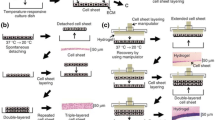Abstract
We describe a design algorithm to build a cardiac myocyte with specific spatial dimensions and physiological function. Using a computational model of a cardiac muscle cell, we modeled calcium (Ca2+) wave dynamics in a cardiac myocyte with controlled spatial dimensions. The modeled myocyte was replicated in vitro when primary neonate rat ventricular myocytes were cultured on micropatterned substrates. The myocytes remodel to conform to the two dimensional boundary conditions and assume the shape of the printed extracellular matrix island. Mechanical perturbation of the myocyte with an atomic force microscope results in calcium-induced calcium release from intracellular stores and the propagation of a Ca2+ wave, as indicated by high speed video microscopy using fluorescent indicators of intracellular Ca2+. Analysis and comparison of the measured wavefront dynamics with those simulated in the computer model reveal that the engineered myocyte behaves as predicted by the model. These results are important because they represent the use of computer modeling, computer-aided design, and physiological experiments to design and validate the performance of engineered cells. The ability to successfully engineer biological cells and tissues for assays or therapeutic implants will require design algorithms and tools for quality and regulatory assurance.
Similar content being viewed by others
References
Chen C.S., Mrksich M., Huang S., Whitesides G.M., Ingber D.E. (1997) Geometric control of cell life and death. Science 276, 1425–1428
Parker K.K., Brock A.L., Brangwynne C., Mannix R.J., Wang N., Ostuni E., Geisse N.A., Adams J.C., Whitesides G.M., Ingber D.E. (2002) Directional control of lamellipodia extension by constraining cell shape and orienting cell tractional forces. FASEB J. 16(10): 1195–1204
Dike L.E., Chen C.S., Mrksich M., Tien J., Whitesides G.M., Ingber D.E. (1999) Geometric control of switching between growth, apoptosis, and differentiation during angiogenesis using micropatterned substrates. In Vitro Cell. Dev. Biol. Anim. 35, 441–448
Hodgkin A.L., Huxley A.F., Katz B. (1952) Measurement of current-voltage relations in the membrane of the giant axon of Loligo. J. Physiol. 116, 424–448
Kleber A.G., Rudy Y. (2004) Basic mechanisms of cardiac impulse propagation and associated arrhythmias. Physiol. Rev. 84(2): 431–488
Priori S.G., Barhanin J., Hauer R.N., Haverkamp W., Jongsma H.J., Kleber A.G., McKenna W.J., Roden D.M., Rudy Y., Schwartz K., Schwartz P.J., Towbin J.A., Wilde A.M. (1999) Genetic and molecular basis of cardiac arrhythmias: impact on clinical management parts I and II. Circulation 99(4):518–528
Gerdes A.M., Capasso J.M. (1995) Structural remodeling and mechanical dysfunction of cardiac myocytes in heart failure. J. Mol. Cell. Cardiol. 27(3):849–856
Bers D. (2002) Cardiac exciation-contraction coupling. Nature 415, 198–205
Smith G.D., Keizer J.E., Stern M.D., Lederer W.J., Cheng H. (1998) A simple numerical model of calcium spark formation and detection in cardiac myocytes. Biophys. J. 75, 15–32
Shannon T.R., Wang F., Puglisi J., Weber C., Bers D.M. (2004) A mathematical treatment of integrated Ca dynamics within the ventricular myocyte. Biophys. J. 87, 3351–3371
Brette F., Orchard C. (2003) T-tubule function in mammalian cardiac myocytes. Circ. Res. 92, 1182–1192
Alberty J., Carstensen C., Funken S. (1999) Remarks around 50 lines of Matlab: short finite element implementation. Num. Algorithms. 20, 117–137
Langer G.A., Peskoff A. (1996) Calcium concentration and movement in the diadic cleft space of the cardiac ventricular cell. Biophys. J. 70, 1169–1182
Pratusevich V.R., Balke C.W. (1996) Factors shaping the confocal image of the calcium spark in cardiac muscle cells. Biophys. J. 71, 2942–2957
Tan J., Liu W., Nelson C., Raghavan S., Chen C. (2004) A simple approach to micropattern cells on common culture substrates by tuning substrate wettability. Tissue Eng. 10, 865–872
Baader A.P., Buchler L., Bircher-Lehmann L., Kleber A. (2002) Real time, confocal imaging of Ca(2+) waves in arterially perfused rat hearts. Cardiovasc. Res. 53, 105–115
Genka C., Ishida H., Ichimori K., Hirota Y., Tanaami T., Nakazawa H. (1999) Visualization of biphasic Ca2+ diffusion from cytosol to nucleus in contracting adult rat cardiac myocytes with an ultra-fast confocal imaging system. Cell Calcium 25:199–208
Author information
Authors and Affiliations
Corresponding author
Additional information
W.J. Adams and T. Pong contributed equally to this work.
Rights and permissions
About this article
Cite this article
Adams, W.J., Pong, T., Geisse, N.A. et al. Engineering design of a cardiac myocyte. J Computer-Aided Mater Des 14, 19–29 (2007). https://doi.org/10.1007/s10820-006-9045-6
Published:
Issue Date:
DOI: https://doi.org/10.1007/s10820-006-9045-6




